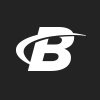Although it's a good idea to frequently switch out your workouts, three movements that should always be included, especially for hardgainers, are the so-called "Big Three"; bench press, squat, and deadlift.
These three movements are called this mainly because they work several muscle groups, and for overall strength and mass gains, they just can't be beat. I'm going to go into a little detail about form, variations, and purpose of each one of them.
EXERCISE 1 Barbell Bench Press
The good old bench press is probably one of everyone's favorite movements. It is the best overall compound upper body movement. A correctly done bench press works the pectorals, front deltoids, and triceps.
The usual form is to lie on a flat bench and put your hands on the bar slightly more than shoulder width apart. Putting them more than shoulder width brings the deltoids more into play, works the outer pecs more, and if done with too wide a grip risks a rotator cuff injury.
The Bench Press
Watch The Video - 6:48
Putting them closer brings the inner pecs and triceps more into play, and it become Close-Grip Bench Press, a great movement for the triceps. You should lift the bar up over your head, then slowly bring it down to the lower part of your pecs, and then raise it up till it is over your head again.
You do not raise the bar straight, but rather in a J-shaped curve. This movement can also be done with dumbbells. Doing it this way allows you to make each side of your body work independently, and strengthens stabilizing muscles. The bench press is the fundamental key to success for any chest workout.
EXERCISE 2 Barbell Squat
The squat is equally important, and possibly even more important, though probably not liked as much. Studies have shown that doing large compound movements, specifically squats, has a positive effect on endogenous testosterone production. A good side effect, I'd say.
Squats work the entire lower body, specifically the quadriceps, hamstrings, glutes, and the muscles that make up the calves. When doing squats, foot placement makes a big difference. A wide stance and/or the toes point out brings the inner thighs more into play, whereas a closer stance brings the outer thigh more into play.
The standard position is feet shoulder width apart with the toes pointed slightly outward. When doing squats, the bar should rest between the rear deltoid and the traps. The back should be kept straight and the head up. Definitely use a belt and work hard on keeping that back straight.
I've hurt my back doing squats because I bent my back, and trust me you don't want to ever hurt your back. Another key is how low to go. You really need to get to parallel, with your thighs parallel to the floor. It's even better if you can get below parallel. The problem with this is that it hurts most people's knees.
But you will really work the muscles better if you can get low. Try taking a light weight and work on your form. Eventually, you'll be getting parallel and even below parallel. But remember, do what's comfortable and don't push yourself too hard. With squats, get the form, and then get the weight. Go slowly, and your whole lower body will start growing.
EXERCISE 3 The Deadlift
The deadlift is probably the most neglected of the big three. It's a difficult movement and there's not always room at the gym to do it. But no other movement uses so many muscle groups, including the traps, lats, lower back, glutes, hamstrings, quads, and calves. Form is key to deadlifts as well.
The risk for hurting yourself if done incorrectly is equal to or as great as squats. There is also a debate if deadlift should be done on leg day or back day. I usually do it on back day, my personal opinion being that it's one of the best back exercises, and since I do squats on leg day, I like to have one of the "Big Three" on back day, but it's up to you.
When deadlifting, it's important to wear a belt and practice the form with low weight. Find a clear spot in the gym or a powerlifting platform if you have one. Place the barbell in front of you, and grab it with a shoulder-width grip. Place one hand on the bar with an overhand grip, the other with an underhand grip.
You don't have to do this if you don't want to, but it's important when you start going heavy, as it prevents the bar from rolling out of your hands. Bend your knees, and bring them up close to the bar to keep your back straight. Like squats, it is extremely important to keep your back straight!
To start the movement, push your legs downward and explode upwards standing up straight (and keeping your back straight at all times). Then throw your shoulders, back and your chest out to really work the upper back. Then slowly bend your knees, bend your waist forward (back straight again) and set the weight down to complete the rep.
This movement takes some practice, and once again be careful to work on the form and not worry about the weight so much. With practice, you'll get good at it and it will become a key part of your workout.
Conclusion
There you have the "Big Three". No other compound movements work the body so well. They should always be a part of your routine.
They should also usually be done at the beginning of a workout, with isolation movements afterwards. These three movements will help you to hit those strength and mass gains like nothing lese.
